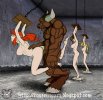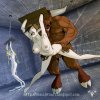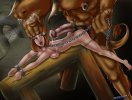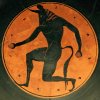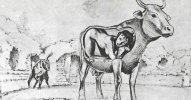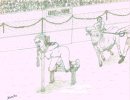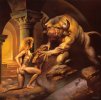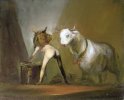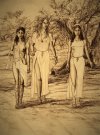Well, actually it was one of Cam's manips that inspired me to try my own version of the 'Judgement of Paris.
So I hope you don't mind if I post it here as well together with the text that goes with it.
Comments always welcome!
View attachment 1015187
Like ‘Andromeda’ this is one of the favourite topics from Greek mythology for artists, so I thought I might have a go as well.
Instead of just showing three lovely but interchangeable women I decided to characterise the goddesses according to what is known about them from mythology.
I used three Archaic korai from the acropolis as inspiration for poses and garments. Naturally not for the ladies themselves, because Greek artists of this period had no real interest in female bodies (very much in contrast to me) but just took the same bodies and faces they used for the male Kouroi added a different hairstyle, garments (girls could not be naked), and two bulbs underneath on the torso.
Naturally this actually makes not much sense, because the mythology was already old when these statues were produced during the Archaic period, but nobody has an idea about how old the idea for these goddesses are (Early Iron Age, Late Bronze Age, Middle Bronze Age?) and what garments were in fashion in this unknown period.
In contrast to historical reality, I also did choose white cloth for the garments, just because the modern viewer is so used to the marble statues that lost their original colourful (and often abominable) painting.
I tried to differentiate the goddesses a bit by age, since Hera, wife of Zeus, mother of a number of Olympic gods, and goddess of marriage and childbirth definitely fits the description MILF. She symbolises what a good Greek woman should be: the ‘Lady of the Oikos’, meaning she is in charge of the household, keeping the money together, giving birth to many, many children and raising them. A terror to her husband, who consequently spends most of his time outside, where a good Greek woman does not go.
Athena is a child of Zeus, but not of Hera. She just popped out of Zeus’ head (with a little help of Hephaistos and a big axe). You might imagine that the goddess of childbirth is not too fond of this concept and usually we find Hera and Athena on different sides.
Athena is a virgin not interested in sexual relations. She is goddess of wisdom and (technical) warfare but she has a playful side as well. Once she invented the aulos, a kind of flute. When she presented it to the fellow gods they all started to laugh, because she looked so funny with blown up cheeks and n threw the flute away. In short: she is a spoiled teenage brat and daddy’s little favourite.
Aphrodite now is different. She is not originally part of the happy little family on Mount Olympos and actually older than many of the gods there. Uranos (the sky) was challenged by his son Kronos (time) who cut off his genitals and threw them into the sea. The sea was fertilised and Aphrodite was born (from ‘foam’) and reached the island of Cyprus. Kronos is the father of Zeus, so Aphrodite actually is one generation above him.
Most scholars think, and there is good evidence for this, that she is a Greek version of the Levantine goddess Astarte (Near Eastern Ishtar) and Greeks, when they started to get around a bit again in Early Iron Age, learned about her in Cyprus. Astarte is a very powerful goddess, amongst other aspects a goddess of war. The Greeks already had Athena for this and Hera for childbirth so Aphrodite was reduced to a goddess of ... no, not ‘fertility’ or some other prissy nonsense ... a goddess of sex, desire and enjoyment. Thus, for her appearance I did choose that most attractive type of Cypriote girl, petite, slender, tanned, with thick black curls that vividly demonstrates the closeness of the island to the mainland in the east and south that you can find on both sides of the Green Line, despite the modern myths of origin.
The setting naturally has to be Mediterranean. Paris, the son of Priam King of Troy, was born in what today is western Turkey.
It is a common misconception that the story is part of the Homeric epics. It is not. Homer only wrote about the very last weeks of the last year of the Trojan war. Everything else is known from other sources. Especially the reason, prelude and early war stories are known from the Kypria, which literally means ‘Cypriot Stories’.
Naturally Classical scholars hurry to inform us that this title does not mean these were Cypriot stories, because they have to be Greek and Cyprus was not a part of the Greek world (at least not until Hellenistic times, when it became Egyptian ... erm ...) and Greeks invented everything themselves and never ever were culturally influenced by ... anyway, they insist that the title was chosen only because Aphrodite, one of many goddesses mentioned in them, actually came to Greece as cultural influence from Cyprus ... whoops.
Whatever,
I think ‘Cypriote Stories’ means Cypriote stories (revolting idea!) and so I did choose some of the oldest olive trees from that lovely island as a background. A friend told me they were burned in a bushfire some years ago ...
So, what about the ladies?
Hera in the centre just coming from her place in Samos is wearing a chiton, the usual Ionian garment. Made of finest linen, lowered around the neck and not sewn together in the lower half it helps to reveal her assets, while hiding the problematic zones around the waist.
She is perfectly convinced that she will win. After all she is the wife of the king of gods, isn’t she? And what is a hierarchy good for, if it does not mean that those on top will get what they want? Still, she is really, really pissed off that Zeus, that old disloyal jerk, did not just give the apple, that clearly belongs to her, but instead staged this stupid ‘competition’. With a
mortal as a jury!
“Disgusting!” she thinks. “But those little humans always can be bought or frightened. I’ll promise him to be ruler of the world. What else would such a stupid slave dream of? And naturally Athena this overweening, spoilt, vane little brat has to take part! Oh my, girl! You are way out of your depth here! You did not even think to dye your hair and your make up is pathetic! And this bit of flimsy jewellery! Poor girl, she did not notice she is still wearing her every-day sandals. And who else is taking part? Ah, this little outlandish slut Aphrodite. Well, who is taking
her serious?”
Athena to the right naturally is wearing the Athenian peplos, made from heavy wool and doubled on top to hide female attributes as much as possible. She is not stupid, and thus she does what Athenian girls do when they want to show their goodies: just take advantage of the fact that the garment actually is nothing else but a rectangular piece of cloth, not sewn together at the side. Still, she is pouting as usual, because the effort seems to be wasted on a mere human being. And she wants this beautiful golden apple, so Daddy should have given it to her! But now she has to compete with this old hag Hera and this darky foreigner who always smiles as being secretly amused. The bitch is half naked, like a boy, and look at her sandals! It looks as if her legs were tied up. Does she belief someone thinks this is sexy?!? She isn’t even ashamed to smile at this stinking mortal being, who is not even a Greek! Bah, mortals have to be afraid of gods! And mortal men are so damned stupid, they need a wise woman telling them what to do! If he has just a little bit of brain, he will realise that wisdom is the thing he is most in need of, so he will be overwhelmed with thankfulness about her bribe.
Aphrodite does not wear any jewels, because she is the most precious thing herself. And she knows that she will win. The fat cow and the stupid kid belief they can bribe the judge. But they never realised that this is not important. What is important is to control whoever sets the rules and choses the judge. And did old Zeus not suddenly feel an irresistible desire to spent some quality time with his boy toy Ganymed? And so felt the need to get his wife and daughter out of the way. And so appointed a male human to be the judge?
With a mortal male it does no matter a bit what Hera and Athena have to offer, because human males don’t think with their brain. And this is why Aphrodite just can’t lose.
“And isn’t he cute this little shepherd?” she thinks. “When all is done, I might disguise as a shepherdess to have some fun ... or as a sheep if he prefers.”













